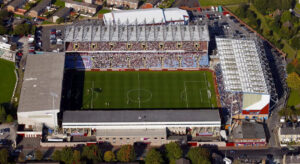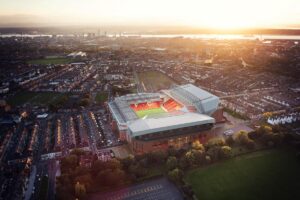Stadiums of the 2025/26 Premier League Season
The 2025/26 Premier League season is set to captivate fans with its blend of historic venues and modern arenas, each telling a unique story of footballing heritage. With Leeds United, Burnley, and Sunderland promoted, and Everton debuting their new Everton Stadium, the league’s 20 stadiums offer a spectrum of tradition and innovation. In this blog, we’ll present a complete list of the season’s stadiums, then dive into the oldest, newest, and most iconic grounds, highlight a defining historical moment for each of the promoted teams’ stadiums, and sprinkle in fascinating details about these venues that shape the Premier League’s soul.
All 20 Premier League Stadiums for 2025/26
Here’s a comprehensive table of the teams and their home stadiums for the 2025/26 season, including approximate capacities and locations.
|
Team
|
Stadium
|
Capacity
|
Location
|
|---|---|---|---|
|
Arsenal
|
Emirates Stadium
|
60,704
|
London
|
|
Aston Villa
|
Villa Park
|
42,918
|
Birmingham
|
|
Bournemouth
|
Dean Court (Vitality Stadium)
|
11,307
|
Bournemouth
|
|
Brentford
|
Brentford Community Stadium
|
17,250
|
London
|
|
Brighton & Hove Albion
|
Falmer Stadium (Amex Stadium)
|
31,876
|
Brighton
|
|
Burnley
|
Turf Moor
|
21,944
|
Burnley
|
|
Chelsea
|
Stamford Bridge
|
40,173
|
London
|
|
Crystal Palace
|
Selhurst Park
|
25,194
|
London
|
|
Everton
|
Everton Stadium
|
52,769
|
Liverpool
|
|
Fulham
|
Craven Cottage
|
29,589
|
London
|
|
Leeds United
|
Elland Road
|
37,645
|
Leeds
|
|
Liverpool
|
Anfield
|
61,276
|
Liverpool
|
|
Manchester City
|
Etihad Stadium
|
52,900
|
Manchester
|
|
Manchester United
|
Old Trafford
|
74,197
|
Manchester
|
|
Newcastle United
|
St James’ Park
|
52,258
|
Newcastle
|
|
Nottingham Forest
|
City Ground
|
30,404
|
Nottingham
|
|
Sunderland
|
Stadium of Light
|
49,000
|
Sunderland
|
|
Tottenham Hotspur
|
Tottenham Hotspur Stadium
|
62,850
|
London
|
|
West Ham United
|
London Stadium
|
62,500
|
London
|
|
Wolverhampton Wanderers
|
Molineux Stadium
|
31,750
|
Wolverhampton
|
With an average capacity of around 42,000, these stadiums reflect the Premier League’s global appeal, hosting passionate crowds from London’s seven clubs to the North’s fervent fanbases.
The Oldest Stadium: Turf Moor (Burnley)
 Established: 1883
Established: 1883- Details: Turf Moor, home to Burnley, holds the title of the oldest stadium in the 2025/26 Premier League season. In use since 1883, it’s one of the world’s oldest continuously used football grounds. Its compact 21,944 capacity creates an intense, intimate atmosphere, amplified by the “Longside” stand where the Clarets’ most vocal supporters gather.
- Historical Moment: On October 14, 1968, Turf Moor hosted Burnley’s 5-1 thrashing of Leeds United in a First Division match, a defining moment that showcased the ground’s fearsome reputation during Burnley’s golden era. The tight confines and roaring crowd overwhelmed the visitors, cementing Turf Moor’s status as a fortress.
- Fascinating Fact: The stadium’s narrow tunnel forces opposing players to brush shoulders, a deliberate design quirk that adds a psychological edge for Burnley. Its “Cricket Field Stand” also nods to its shared history with Burnley Cricket Club, a unique piece of its 19th-century roots.
The Newest Stadium: Everton Stadium (Everton)
 Established: 2025
Established: 2025- Details: The Everton Stadium at Bramley-Moore Dock, debuting for the 2025/26 season, is the Premier League’s newest venue. With a 52,769 capacity, this waterfront arena reflects Liverpool’s maritime heritage through its ship-hull-inspired brickwork. It replaces the historic Goodison Park, marking a new chapter for the Toffees.
- Historical Moment: As a brand-new stadium, it has yet to forge its defining moments, but its opening match in August 2025—likely a high-profile Premier League clash—will set the tone. The “Fan Plaza” outside, featuring preserved Goodison turnstiles, will host emotional pre-match gatherings, linking past and present.
- Fascinating Fact: The stadium’s location on the Mersey waterfront allows fans to arrive by boat, a nod to Everton’s dockside roots. Its design includes sustainable features like rainwater harvesting, making it a modern marvel.
The Most Iconic Stadium: Anfield (Liverpool)
 Established: 1884
Established: 1884- Details: Anfield, with its 61,276 capacity, is arguably the Premier League’s most iconic stadium, thanks to its storied history and the legendary Kop stand. The spine-chilling rendition of “You’ll Never Walk Alone” reverberates globally, making it a bucket-list destination for football fans.
- Historical Moment: On May 25, 2005, Anfield’s atmosphere fueled Liverpool’s incredible comeback against AC Milan in the UEFA Champions League final (though played in Istanbul, the spirit of Anfield was credited). Locally, the 4-3 victory over Newcastle United on April 3, 1996, remains a Premier League classic, with the Kop’s roar pushing Liverpool to a last-gasp winner.
- Fascinating Fact: The Shankly Gates, inscribed with “You’ll Never Walk Alone,” honor legendary manager Bill Shankly. The Kop’s single-tier design maximizes noise, creating a “12th man” effect that’s intimidated opponents for decades.
Spotlight on Promoted Teams’ Stadiums
The promoted sides—Leeds United, Burnley, and Sunderland—bring historic and vibrant venues to the Premier League. Here’s a closer look, including a defining historical moment for each.
Elland Road, Leeds United’s 37,645-capacity home since 1919, is a passionate fortress established in 1897. Its East Stand, or “Gelderd End,” erupts with “Marching On Together,” blending modern upgrades with a gritty soul marked by a Don Revie statue. In 1970, it hosted a 2-2 European Cup semi-final draw with Celtic, dubbed the “Battle of Britain,” where 46,000 fans fueled Leeds to the final. In 1989, fans famously dug up the pitch to delay a relegation match, a testament to their devotion. Burnley’s Turf Moor, the league’s oldest stadium since 1883, packs intensity into its 21,944 seats. The “Longside” stand drives the Clarets’ spirit, and its wooden seats and terraced-house proximity evoke Victorian roots. In 2020, Turf Moor’s roar powered a 2-0 upset over Manchester United, proving its modern might. Sunderland’s Stadium of Light, opened in 1997 with a 49,000 capacity, replaced Roker Park and reflects the club’s massive fanbase. Its “Roker Roar” and “Ha’way the Lads” chants create a cauldron, with murals of the 1973 FA Cup win inspiring players. In 2016, a 3-2 win over Chelsea, sealed by Jermain Defoe’s volley, ensured Premier League survival, shaking visitors with its atmosphere. The Davy Lamp monument outside honors Sunderland’s mining heritage.
Additional Stadium Highlights
- Old Trafford (Manchester United): The largest club stadium in the UK at 74,197, dubbed the “Theatre of Dreams.” The Munich Tunnel commemorates the 1958 air disaster, adding emotional weight to its legacy.
-
Tottenham Hotspur Stadium, opened in 2019, boasts a unique feature: an on-site microbrewery that crafts bespoke beers for matchdays. Located within the 62,850-capacity venue, this brewery, one of the first in a football stadium, produces exclusive brews like the “One of Our Own” pale ale, enhancing the fan experience. Supporters can enjoy freshly poured pints in the stadium’s Beavertown Taproom, adding a modern, artisanal twist to the electric atmosphere of Spurs’ home games.
- Tottenham Hotspur Stadium: Opened in 2019, this 62,850-seat tech marvel features a retractable pitch for NFL games and a microbrewery, blending innovation with a 17,500-seat “White Wall” South Stand for unmatched atmosphere.
- Craven Cottage (Fulham): Since 1896, this riverside gem has a listed 1905 Johnny Haynes Stand, the only one in the Premier League, and fans can watch from the Thames bank, a unique touch.
- Dean Court (Bournemouth): The smallest at 11,307, its tight layout makes it a noisy trap for opponents, with the Ted MacDougall Stand honoring the club’s record goalscorer.
 From the historic 142-year legacy of Turf Moor to the state-of-the-art Everton Stadium, the 2025/26 Premier League’s venues weave together tradition and innovation. Anfield’s legendary aura, Elland Road’s fiery passion, and the Stadium of Light’s grand scale promise unforgettable moments. Which stadium’s story calls to you? Get your tickets from here and immerse yourself in the electric atmosphere, becoming part of the thrilling matches that define the Premier League!
From the historic 142-year legacy of Turf Moor to the state-of-the-art Everton Stadium, the 2025/26 Premier League’s venues weave together tradition and innovation. Anfield’s legendary aura, Elland Road’s fiery passion, and the Stadium of Light’s grand scale promise unforgettable moments. Which stadium’s story calls to you? Get your tickets from here and immerse yourself in the electric atmosphere, becoming part of the thrilling matches that define the Premier League!
